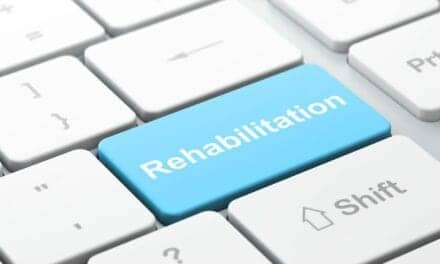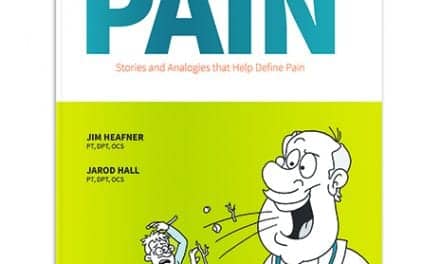CAPTION: A physical therapist at ATI Physical Therapy leads a patient through an upper body exercise to treat pain symptoms.
By Gerald Dolce, PT, DPT, OCS, COMT, and Tyler Meyers, PT, DPT, OCS, COMT
What is Pain?
Pain is a response to a perceived or real threat of tissue damage leading to the emotional awareness and physical sensation that happens in consequence and a necessary sensation to help prevent further damage. However, this response can sometimes be inconsistent with the physical tissue damage and with the person experiencing the pain. Historically, chronic pain has been defined in terms of duration, but this definition does not allow for consideration of mechanism. Largely depending on the patient, healing the physical tissue damage or modifying lifestyle may lead to pain resolution. In other cases, people may have a lack of connection with the insult and continued pain. Both of these can lead to abnormal long-lasting pain, categorized as chronic pain.
Philosophy on Treating Pain
Pain is multifactorial in nature, a product of our physical and emotional states, existing not as an input, but as an output. The nature and severity of the damage (eg, getting punched in the nose vs a paper cut), our feelings about the aforementioned nature and severity of the damage, and our everyday stress level can all have a significant impact on how our brains perceive pain.
Pain is individualized.1 Everyone has a different experience. Therefore, it is unfair to treat our patients’ pain in a one-size-fits-all fashion. Patients with the same diagnosis can have vastly different responses to the same treatment or modality. The physical therapist must be versatile and have many tools in their tool belt to tackle any situation that may arise.
Treating Pain
Physical therapists are function restorers primarily and pain relievers secondarily. Sometimes these roles overlap and pain must be reduced in order to improve function. There are many tools and techniques available for physical therapists to treat pain, ranging from simple pain science education to physical agents, both having a neurophysiological effect on the patient’s pain. With a variety of techniques, we can not only make the treatment idiomatic, but adhere to the concept that pain must be reduced.
Education
Physical therapists are educators at the purest form: We tell patients what is going on with their body and assist with improving it. Research shows that an increased knowledge of how pain works correlates with improved outcomes.2 When working with patients in chronic pain particularly, we may hear them say that doctors, or even ourselves, tell them the pain “is in their heads.” This is not fair for the majority of patients as they are experiencing real, physical pain, and devaluing their experience will only serve to possibly increase anxiety and severity of pain.3 Neuroscience education assists with treating pain by using diagrams, pictures, and metaphors to connect with the patient, nurture their understanding of pain, and develop trust. While proper education sessions may last up to several hours, even abbreviated sessions can be helpful. We like to encourage patients to read Why Do I Hurt? A Patient Book About the Neuroscience of Pain by Adriaan Louw.
Pain Neuromatrix Approach
The pain neuromatrix approach aims to accomplish pain reduction through a method sensitive to the individual experiencing pain. The pain neuromatrix is the combination of cortical mechanisms that when activated cause pain.4 Pain may not be an adequate describer of the actual tissue damage. There can be considerable pain with mild or no injury, while there may be very little pain with severe injury or consequence. With this model, we use a graded education and activation of the pain neuromatrix. For this approach to be effective, the therapist must be an expert at educating their patient and the patient must trust the therapist completely. It is up to the therapist to achieve the patient “buy-in.”
A baseline nociceptive input is found out and then slowly pushed further as the patient gets used to their new normal level of discomfort. For example, take someone who cannot bend forward to tie their shoes and start by slowly breaking down the movement or changing the context. You may have them bend forward sitting instead of standing or have them reach for their purse off the ground instead of tying their shoes. Even having them visualize the painful movement can be helpful. Because these modifications are inherently less threatening, they are less likely to activate the pain neuromatrix. Then, goals can be moved forward as the patient progresses to each new functional baseline as they can tolerate more and more activity.4 Because of the gradual progression, patients will make improvements sometimes without realizing they are being made.
A positive with using neuroscience education practices is that they may be used in conjunction with other treatments, such as physical agents, which exist to change the chemical composition in the muscle and possibly target the reduction in vascularization. Such techniques include exercise, electrical stimulation, dry needling, joint mobilization, and instrument- and non-instrument-assisted soft tissue mobilization.
Exercise
Physical inactivity can be an added insult to chronic pain, with the WHO and CDC claiming physical inactivity as a risk factor for noncommunicable diseases and death.5 As evidence supports, physical activity may improve quality of life, emotional affect, sleep, and cognitive abilities, as well as disease risk modification.5 Exercise as a primary approach for chronic pain can be challenging, and although proven effective, there is limited knowledge of the appropriate dose for a given disease or patient type.5 Despite this, many instances show it has a positive effect on changing a person’s perspective and function. Many studies have focused on the physical function of pain post-exercise, and there has been some evidence suggesting the more exercise performed properly, the fewer the pain behaviors.6
Aerobic activity, strength training, and flexibility activities are just a few that help to change a person’s perception of pain. A good product for strength exercises in-clinic and at-home is CanDo exercise bands made by Chattanooga Medical Supply, Chattanooga, Tenn. These low-powder latex bands increase in resistance by color so it is easy to progress patients as they become comfortable with treatment. Another source for natural rubber latex therapy bands, straps, tubing, and balls is Stretchwell Inc, Warminster, Pa.
[sidebar float=”right” width=”250″]Product Resources
The following companies provide products for pain management:
Amrex Electrotherapy Equipment
www.amrexusa.com
Ari-Med Pharmaceuticals
www.ari-med.com
Battle Creek Equipment Company
www.battlecreekequipment.com
OPTP
www.optp.com
Parker Laboratories
www.parkerlabs.com
PHS Medical by Pivotal Health Solutions
www.phsmedicalsolutions.com
Sore No More
www.sorenomore.com
Southwest Technologies
www.elastogel.com[/sidebar]
Electrical Stimulation (ESTM) and Pain Management
Electrical stimulation (ESTM) for the treatment of pain has been used for centuries, dating back to ancient Egyptians. ESTM, specifically the transcutaneous electrical nerve stimulation (TENS) unit, utilizes the Gate Control Theory of pain where large-diameter fibers recruit inhibitory neurons, and these exert their influence on both large- and small-diameter fibers which “close” the gate.7 As a result, TENS can assist in reducing pain meddling at home and work, decreased use of other therapies, and decreased consumption of pain medications.7 Using TENS with chronic pain patients can be effective at increasing pain thresholds and reducing tension in their irritable areas. Starting a treatment with a TENS unit may have an improvement in performing exercises in the clinic and tolerating movements during manual mobilization. By increasing tolerance to these movements you can now exert a neurophysiological effect on their body that you may have struggled with before. Many companies work with healthcare providers and patients to cover the cost of these units, which make TENS an affordable modality for most patients at home. A unit that is effective at performing these functions is the EMSI TENS from Electricostim Medical Services, Tampa, Florida.
Other non-invasive options include hot/cold therapy packs that provide moist heat and therapeutic cooling. Battle Creek Equipment, Freemont, Ind, provides a line of such products including Thermaphore Classic Moist Heat Packs and Ice It! Cold Therapy. Likewise, for temporary pain relief, topical analgesics may be helpful. Topicals are affordable, and available as easy-to-use creams and gels. Sore No More All Natural Pain Relieving Gels from Sore No More, Moab, Utah, offers a complete line of topical products for warming and cooling. Helix Professional Pain Relief from Parker Laboratories, Fairfield, NJ, is another topical in a professional formulation that can also be used with hands-on therapy to provide temporary pain relief from arthritis, joint pain, muscle pain, and backache.
Dry Needling
Dry needling (DN) is an effective technique that more and more clinicians are utilizing to reduce patients’ chronic pain. DN is “a skilled intervention that uses a thin filiform needle to penetrate the skin and stimulate myofascial trigger points, muscular, and connective tissue.”8 It is suggested that low blood flow correlates with increased pain levels, and in patients with shoulder and cervical myofascial pain, DN was found to increase blood flow in those areas.8 This helps us understand the concept of if a patient has been in pain for a significant duration of time, improving blood flow to areas that have been deprived may decrease their pain. ATI Physical Therapy prefers AGUPUNT FDA-approved needles – easy to use and comfortable in hand – from AGUPUNT, Barcelona, Spain. The company’s color-coded safety tips helps identify which size of needle is being used, which is especially important when performing on various muscles in one treatment session.
Instrument-Assisted Soft-Tissue Mobilization
Similar to massage therapy, instrument-assisted soft-tissue mobilization (IASTM) techniques can help facilitate the healing process. A study performed by Kim et al in 2017 suggests that IASTM can help ankle range of motion (ROM) in chronic ankle instability and improve soft tissue function in people with chronic Achilles tendinopathy. When performing this technique to areas that may be stuck in chronic states of inflammation, it may help “restart” the healing process and generate turnover of the injured or irritated tissue. If the causative injury is no longer there, it is important to utilize IASTM in specific directions to facilitate the desired results. An accessible product that can be used in the clinic is RockBlades from RockTape, Silicon Valley, Calif. They are comfortable and allow up to six different types of grips to adhere to any surface of the body.
Joint Mobilization
Joint mobilization can help change the neurophysiological effect in a patient’s area of concern. It is important for physical therapists to have education in the various techniques of joint mobilization when evaluating patients and determining the best options for reducing pain. These neurophysiological effects can be found at the area of treatment and may include increases in pressure pain threshold, decreased visual analog scale rating, change in skin temperature, and decreased tensioning of muscles.10 The big question is how long can these effects last? Some studies have suggested that there is moderate- to high-quality evidence of immediate clinical improvement in people with chronic neck pain who received spinal manipulation. Others have refuted this. When looking at any positive influence a technique will have on a patient’s pain, it is important to realize that not one modality or technique will work alone. Similarly, joint mobilization alone may only last up to 5 minutes, but conjunction with other treatments may have a stronger effect over time.10
A multitude of factors determine what techniques and approaches will work for each patient. Therapist’s preference, patient preference, objective injury, and the patient’s own motivation and goals will determine what is most appropriate Physical therapists must be open-minded, willing to adapt, and willing to move beyond their comfort zones and biases to effectively and humanely treat pain. It would be arrogant to describe one’s own approach as the be-all and end-all of best practice. We must be self-aware and understanding of our own strengths and weaknesses to improve another person’s function and quality of life. PTP
Gerald Dolce, PT, DPT, OCS, COMT, and Tyler Meyers, PT, DPT, OCS, COMT, are Clinic Directors at ATI Physical Therapy. For more information, contact [email protected].
References
- Moseley GL. Reconceptualising pain according to modern pain science. Physical Therapy Reviews. 2007;12(3):169-178.
- Louw A, Diener I, Butler DS, Puentedura EJ. The effect of neuroscience education on pain, disability, anxiety, and stress on chronic musculoskeletal pain. Arch Phys Med Rehabil. Dec 2011;92(12):2041-2056.
- Louw A. Why Do I Hurt?: a Patient Book about the Neuroscience of Pain. Minneapolis, MN: Orthopedic Physical Therapy Products; 2013.
- Moseley GL. A pain neuromatrix approach to patients with chronic pain. Manual Therapy. 2003;8(3):130-140.
- Ambrose KR, Golightly YM. Physical exercise as a non-pharmacological treatment of chronic pain: Why and when. Best Pract Res Clin Rheumatol. 2015;29(1):120-130.
- Fordyce W, McMahon R, Rainwater G, et al. Pain compliant-exercise performance relationship in chronic pain. PAIN. 1981;10(3):311-321.
- Hegedus EJ, Goode A, Butler RJ, Slaven E. The neurophysiological effects of a single session of spinal joint mobilization does the effect last? JMMT. 2011;19(3):143-151 (4)
- Henderson J. Peripheral nerve stimulation for chronic pain. Cur Pain Headache Rep. 2008;12:28-31.
- Dunning J, Butts R, Mourad F, Young I, Flannagan S, Perreault T. Dry needling: a literature review with implications for clinical practice guidelines. Phys Ther Rev. 2014;19(4):252-265.
- Vernon H, Humphreys BK. Chronic mechanical neck pain in adults treated by manual therapy: A systematic review of change scores in randomized controlled trials of a single session. J Man Manip Ther. 2008;16(2):E42-E52.
Related Content:
Pain Management Product Showcase
Enhanced Physical Therapy is Part of Trial to Determine the Best Back Pain Management Approach
Patellofemoral Pain Management Includes Activity Modification and Load Management





